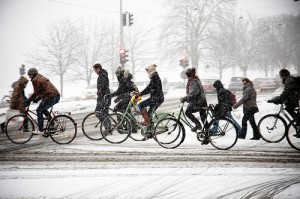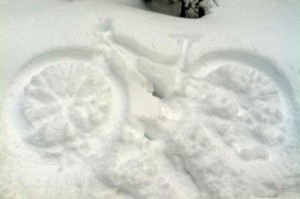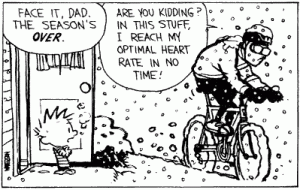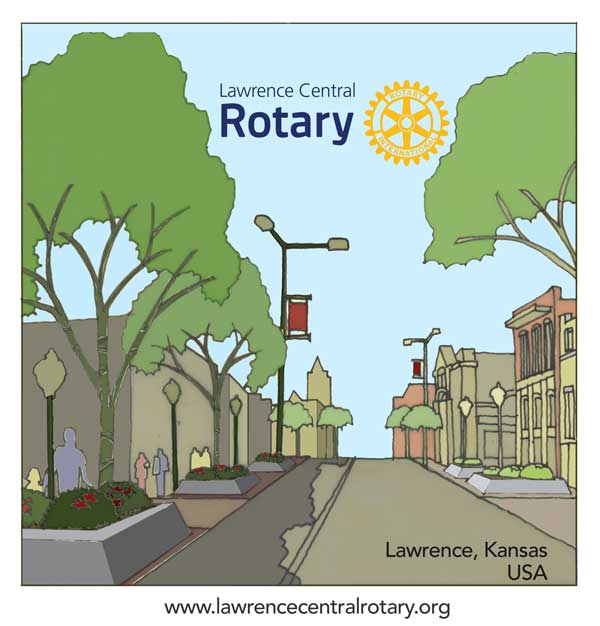Wow! 12-15″ of the white stuff is predicted out there today! If you are brave enough to head out be careful! We dug around and found some pics for you hard core peeps out there!
Category: Good Advice (Page 6 of 9)
We recently saw this story written by Sarah Goodyear in The Atlantic Cities site and are reposting it for our readers. A link to the original story is here.
 Every day outside my son’s Brooklyn school, no matter what the weather, you will see a distinctive pale blue bicycle locked to the rack. It belongs to a 7th-grade girl from a Dutch family whose members have stuck with their traditional practice of riding to school each day, despite finding themselves in the not-so-bike-friendly United States for a few years. This lovely blue city bike was a gift from the parents to their eldest child, who is now almost as tall as a grown woman. She has graduated from riding with her parents, and deserves a first-class vehicle to get to class each day. She is fiercely proud of it.
Every day outside my son’s Brooklyn school, no matter what the weather, you will see a distinctive pale blue bicycle locked to the rack. It belongs to a 7th-grade girl from a Dutch family whose members have stuck with their traditional practice of riding to school each day, despite finding themselves in the not-so-bike-friendly United States for a few years. This lovely blue city bike was a gift from the parents to their eldest child, who is now almost as tall as a grown woman. She has graduated from riding with her parents, and deserves a first-class vehicle to get to class each day. She is fiercely proud of it.
According to the results of a Danish study released late last year, my Dutch friends are giving their daughter a less tangible but more lasting gift along with that bicycle: the ability to concentrate better. The survey looked at nearly 20,000 Danish kids between the ages of 5 and 19. It found that kids who cycled or walked to school, rather than traveling by car or public transportation, performed measurably better on tasks demanding concentration, such as solving puzzles, and that the effects lasted for up to four hours after they got to school.
The study was part of “Mass Experiment 2012,” a Danish project that looked at the links between concentration, diet, and exercise.
Niels Egelund of Aarhus University in Denmark, who conducted the research, told AFP that he was surprised that the effect of exercise was greater than that of diet:
“The results showed that having breakfast and lunch has an impact, but not very much compared to having exercised,” Egelund told AFP.
“As a third-grade pupil, if you exercise and bike to school, your ability to concentrate increases to the equivalent of someone half a year further in their studies,” he added.
The process of getting yourself from point A to point B has cognitive effects that researchers do not yet fully understand. I wrote last year about Bruce Appleyard’s examination of cognitive mapping, in which he compared children who were driven everywhere with those who were free to navigate their neighborhoods on their own. His work revealed that the kids whose parents chauffeured them had a much poorer comprehension of the geography of the places they lived, and also a less fine-grained knowledge of the landscape around them.
In an article about the Danish study from the Davis Enterprise, Egelund says that he thinks there is a deep connection between the way we move our bodies and the way our minds work:
“I believe that deep down we were naturally and originally not designed to sit still,” Egelund said. “We learn through our head and by moving. Something happens within the body when we move, and this allows us to be better equipped afterwards to work on the cognitive side.”
Lots of parents drive their kids to school because walking or driving on streets and roads designed exclusively for cars makes the journey prohibitively dangerous for anyone, especially children. That problem is not easily solved, especially since schools are increasingly being built on the edges of sprawling development, rather than in a walkable context. [PDF]
But many other parents drive their kids because it’s easier, or seems to be easier. They often frame it as a kindness to the child to spare them “trudging” all the way to school, even if that trek is only half a mile long. As these short driving trips become the societal norm, it gets more and more difficult for families to deviate from them. School traffic begets school traffic.
So what could turn the trend around? The connection between active transportation and better physical fitness is well-documented and intuitively easy to draw, and yet apparently not compelling enough. As the Davis Enterprise article points out, even in a U.S. city with relatively good bicycle infrastructure such as Davis, California, parents continue to drive their children to school in huge numbers. More than 60 percent of elementary students in that city arrive for class each morning with their parents behind the wheel. Nationally, as of 2009, only 13 percent of kids in the United States walked or biked to school, down from 50 percent in 1969.
But if more parents realized that packing the kids into the back seat actually affects their ability to learn, would they change their ways? Advocate for building schools in more walkable locations? Demand improved bicycle and pedestrian infrastructure? Or simply make the time and effort required to get to the kids to school under their own steam, accompanying them if need be?
Many parents pay for test prep and after-school enrichment programs to make their kids more academically competitive, and go to great lengths to schedule time for those activities. Imagine if they invested those resources instead in something as simple as helping their children to travel safely from home to school on foot or by bike, arriving ready to learn.
Top image: Sandra Gligorijevic/Shutterstock.com
- Learn how to work on your bike – learn basic bicycle maintenance.
- Learn basic bicycle handling drills
- Ride our obstacle course
- Scouting Merit Badge – work on various requirements of the Bicycle Merit Badge.
- Ride our Track – ride our oval bicycle track indoors!

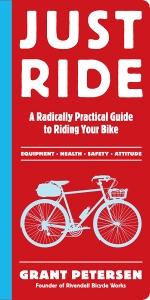
Just Ride is a book by a reformed racer Grant Peterson who’s commuted by bike every day since 1980. The book is described that “in th
e same way that Michael Pollan’s slim bestseller Food Rules brought a gust of common sense to the everyday activity of eating, Just Ride is a revelation. Forget the ultralight, uncomfortable bikes, flashy jerseys, clunky shoes that clip onto tiny pedals, the grinding out of endless miles. Instead, ride like you did when you were a kid—just get on your bike and discover the pure joy of riding it.”
In 87 short, two-to-three page chapters, it covers:
- Riding: Count Days, Not Miles; Corner Like Jackie Robinson; Steer with Your Hips, Shift with Your Legs
- Suiting Up: The Shoes Ruse; Ponchos—the Ultimate Unracer’s Garment
- Safety: #1 Rule—Be Seen; Helmets Aren’t All They’re Cracked Up to Be
- Health and Fitness: Why Riding Is Lousy All-Around Exercise; Saddles Don’t Cause Impotence; Drink When You’re Thirsty—Not Before
Also includes chapters on Accessories, Upkeep, and Technicalities as well as a final chapter titled “Velosophy” that includes the essential, memorable thought: Your Bike Is a Toy—Have Fun with It.
Grant Petersen is the founder and owner of Rivendell Bicycle Works and writes the Rivendell Reader. His writing and opinions have been featured in major bike and outdoor magazines, including Bicycling, Outside, and Men’s Journal. He’s commuted exclusively by bike since 1980, and lives with his family in Walnut Creek, California. His website is www.rivbike.com
It’s a really quick, good read for those of us who sit behind computers more than we should and dream of getting out and going for a ride more — like when we were kids.
Below is a reprint from the WellCommons website

Liberty Memorial Central Middle School students Eleanor Matheis, 13, foreground left, and Mary Reed Weston, 13, right, put on their helmets before bicycling home from school Tuesday, May 22 2012. Kansas has the 27th highest rate of injury-related deaths in the country, according to a new report. Kansas does not require children to wear helmets, but Lawrence has passed an ordinance requiring children, ages 16 and under, to wear a helmet, but doesn't enforce penalties. Traumatic brain injuries account for more than 50 percent of bicycle fatalities among people 20 and under. by Mike Yoder
Kansas has the 27th highest rate of injury-related deaths in the country, according to a new report. The rate, 60.4 per 100,000 people, also is higher than the national average.
To help prevent such fatalities, the report suggests the state implement a bicycle helmet law and expanding its motorcycle helmet law to include all riders.
“Injury is the third-leading cause of death for all age groups in the U.S. and one person dies from injury every three minutes,” said Andrea Gielen, director of the Johns Hopkins Center for Injury Research and Policy and a contributor to the report.
The highest rate was in New Mexico, where 97.8 per 100,000 people die from injuries. The lowest was New York with 37.1 per 100,000 people. Nationally, each year:
- 50 million are medically treated for injuries.
- 29 million are treated in emergency rooms for injuries.
- 2.8 million are hospitalized for injuries.
- $406 billion is lost in medical costs and productivity because of injuries.
- 180,000 die from injuries.
The report found that millions of injuries could be prevented annually if more states adopted policies and programs such as child safety seat and helmet laws. For example, an estimated:
- 69,000 lives were saved between 2006 and 2010 because of seat belts.
- 8,000 lives were saved between 2005 and 2008 because of motorcycle helmets.
- 1,800 lives saved because of child safety seats from 2005 to 2009.
The 76-page report, “The Facts Hurt: A State-By-State Injury Prevention Policy Report,” was released Tuesday by the Trust for America’s Health and the Robert Wood Johnson Foundation. The report looked at 10 key indicators that states can take to prevent injuries. Kansas met all but three:
• Motorcycle helmets. It does not have a law that requires helmets for all riders, but 19 states do. Kansas does require riders under age 18 to wear them.
• Bicycle helmets. Kansas does not require children to wear helmets, but 21 states do. Lawrence passed an ordinance in 2004 that requires children 16 and under to wear a helmet, but it doesn’t enforce penalties. Nationally, about 700 bicyclists are killed each year and 52,000 are injured. Bicyclists under age 16 account for 13 percent of those deaths.
• Teen dating violence prevention. Kansas did not receive an “A” grade in the teen dating violence laws analysis conducted by the Break the Cycle organization in 2010, but six states did. Kansas was among 16 states to earn a “C.” The analysis looked at access to civil protections, access to sensitive services and school response.
“We need to redouble our efforts to make safety, research and policy a national priority,” Gielen said. “There’s compelling evidence that we should adopt, implement and enforce many existing policies and programs to help spare millions of Americans from needless harm.”
The report is available at the healthyamericans.org.

